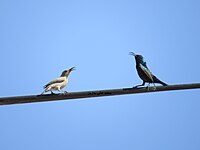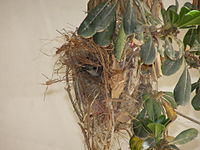
The splendid sunbird is a sunbird. The sunbirds are a group of very small Old World passerine birds which feed largely on nectar, although they will also take insects, especially when feeding young.

The beautiful sunbird, formerly placed in the genus Nectarinia, is a sunbird. It is native to tropical Africa, its range extending from Senegal and Guinea in the west to Sudan, South Sudan, Ethiopia, Tanzania and Kenya in the east.

The garden sunbird, previously known as the olive-backed sunbird, is a species of passerine bird in the family Nectariniidae that is found in the Philippines except on the Palawan island group. It was formerly considered to be conspecific with seven other species: the ornate sunbird, Palawan sunbird, Sahul sunbird, Tukangbesi sunbird, Flores Sea sunbird, South Moluccan sunbird and the Mamberamo sunbird. It is a small, brightly coloured bird with olive-green plumage on the wings and back with a bright yellow chest. It has a long downward-curved bill it uses for taking nectar and capturing insects. It is primarily nectarivorous, but will take insects and spiders, particularly when feeding chicks.

The purple sunbird is a small bird in the sunbird family found mainly in South and Southeast Asia but extending west into parts of the Arabian peninsula. Like other sunbirds they feed mainly on nectar, although they will also take insects, especially when feeding young. They have a fast and direct flight and can take nectar by hovering like a hummingbird but often perch at the base of flowers. The males can appear all black in harsh sunlight but the purple iridescence is visible on closer observation or under good light conditions. Females are olive above and yellowish below.

Loten's sunbird, also known as the long-billed sunbird or maroon-breasted sunbird, is a sunbird endemic to peninsular India and Sri Lanka. Named after Joan Gideon Loten, who was the Dutch governor of colonial Ceylon, it is very similar to the purple sunbird that is found in the same areas and also tends to hover at flowers for nectar, but can be distinguished by the longer bill, the maroon band on the breast and brownish wings. Like other sunbirds, it is also insectivorous and builds characteristic hanging nests.

The variable sunbird or yellow-bellied sunbird, formerly Nectarinia venusta, is a sunbird. The sunbirds are a group of small Old World passerine birds which feed largely on nectar, although they will also take insects, especially when feeding young. Flight is fast and direct on their short wings. Most species can take nectar by hovering like a hummingbird, but usually perch to feed most of the time.
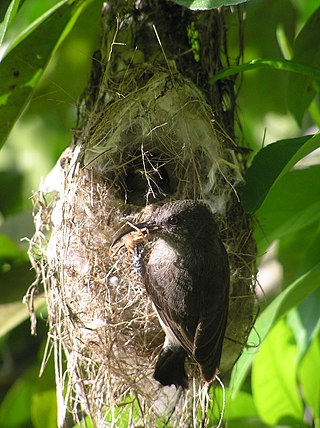
The Seychelles sunbird is a small passerine from the sunbird family. It is named after the French explorer Jean-Jacques Dussumier. It is native to the Seychelles, where it is known as kolibri in Seychellois Creole. This bird is placed in the genus Cinnyris by some authorities and in Nectarinia by others. Although this bird has a limited range, it is described as common and has a stable population, so the International Union for Conservation of Nature has rated its conservation status as being of "least concern".

The malachite sunbird is a small nectarivorous bird found from the highlands of Ethiopia southwards to South Africa. They pollinate many flowering plants, particularly those with long corolla tubes, in the Fynbos.
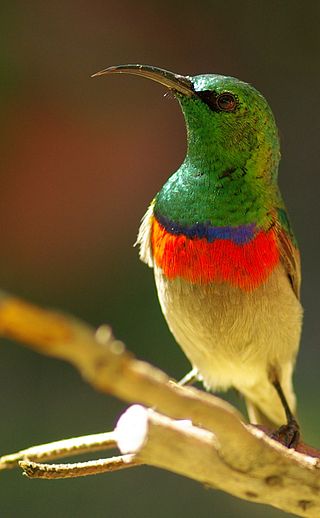
The southern double-collared sunbird or lesser double-collared sunbird is a small passerine bird which breeds in southern Africa. It is mainly resident, but partially migratory in the north-east of its range.
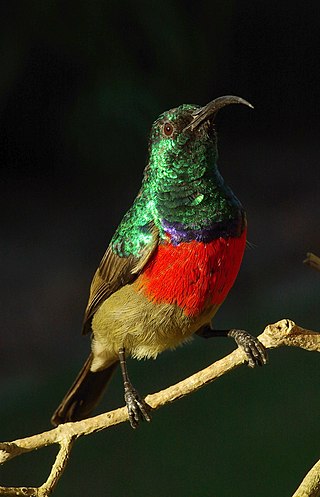
The greater double-collared sunbird is a small bird in the sunbird family. It was formerly placed in genus Nectarinia.

The souimanga sunbird is a small passerine bird of the sunbird family, Nectariniidae. It is native to the islands of the western Indian Ocean where it occurs on Madagascar, the Aldabra Group and the Glorioso Islands.

Menetries's warbler or Ménétries's warbler is a small passerine bird of Southwest Asia belonging to the genus Curruca. The name of the species commemorates Édouard Ménétries, the French zoologist who described the species in 1832. It is closely related to the Sardinian warbler of the Mediterranean basin and is similar to it in appearance.

Bates's sunbird is a species of sunbird in the family Nectariniidae which occurs in Western African forests and Central African rainforests, and locally in other types of forest in Central Africa.
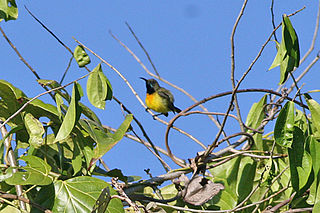
The apricot-breasted sunbird is a species of bird in the family Nectariniidae. It is endemic to the island of Sumba in Indonesia, where its natural habitats are subtropical or tropical moist lowland forests and subtropical or tropical moist montane forests. Although it is quite common, very little is known about its biology, with virtually nothing known about its breeding or diet.

Humblot's sunbird is a species of bird in the family Nectariniidae. It is endemic to the islands of Grand Comoro and Mohéli in the Comoros.

The black-bellied sunbird(Cinnyris nectarinioides) is a small sunbird located primarily in Africa. Two subspecies are recognized: the Cinnyris nectarinioides erlangeri, which is smaller and found in Ethiopia, Somalia, and Kenya; and the Cinnyris nectarinioides nectarinioides, which is larger and found in Kenya and Tanzania. This bird inhabits savannah, wetlands, and terrestrial freshwater areas.
Hofmann's sunbird is a species of bird in the family Nectariniidae. It is endemic to eastern Tanzania.
The Tukangbesi sunbird is a species of passerine bird in the sunbird family Nectariniidae that is found on the Tukangbesi Islands that lie to the southeast of Sulawesi in Indonesia. It was formerly considered to be a subspecies of the olive-backed sunbird, now renamed the garden sunbird.
The Mamberamo sunbird or Rand's sunbird, is a species of bird in the sunbird family Nectariniidae that is found in northern New Guinea. It was formerly considered to be a subspecies of the olive-backed sunbird, now renamed the garden sunbird.
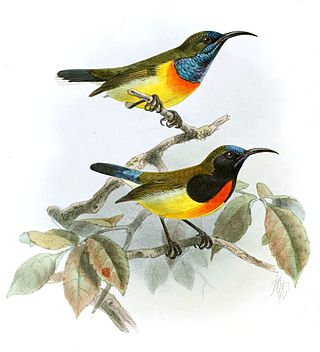
The Palawan sunbird is a species of bird in the sunbird family Nectariniidae that is found on the islands of the Palawan group in the Philippines. It was formerly considered to be a subspecies of the olive-backed sunbird, now renamed the garden sunbird.



